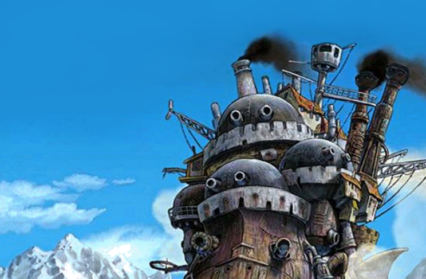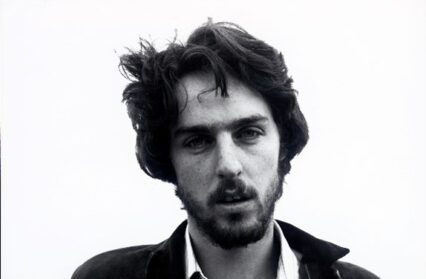Penny Thomas loses herself in the mysterious wonders of Diana Wynne Jones’ Howls’ Moving Castle, another unconventional nomination for the Greatest Welsh Novel.
‘In the land of Ingaray, where such things as seven-league boots and cloaks of invisibility really exist, it is quite a misfortune to be born the eldest of three. Everyone knows you are the one who will fail first, and worst, if the three of you set out to seek your fortunes.’
If your Greatest Welsh Novel has to be set in a land where seven-league boots don’t really exist, then it’s quite possible Howl’s Moving Castle isn’t the contender for you. And invisibility cloaks are, granted, slightly old-hat post JK Rowling. But before you hurry away in your plain old size nines, pause to glance behind you at what you might be overstepping in your haste to catch up with reality.
The author has made it quite clear in these opening sentences that Howl’s Moving Castle is a fairy tale, or at least a tale that happily contains magical elements within it. And so in this story anything can happen. In these first two sentences she has also, with the poise reminiscent of a slightly more whimsical Jane Austen, burst right through the fairy tale conventions and out the other side. The rules where the poor youngest child is the fortunate traveller, trailing along in the wake of the two elder, richer, and probably ugly siblings, and picking up the golden goose or whatever, have been stated and dismissed by over-statement in one deft move. We now know that the story will concern the eldest child of three and that he or she has a bit of a self-esteem issue, and will most likely need to be helped along the road to ‘fortune’ to overcome their own attitudes to their fate. We are expecting a journey, humour, witty writing and character development, with some family drama and fantastically original turns of plot. We can’t wait to know what happens next. Not bad for a first sentence.
Howl’s Moving Castle by Diana Wynne Jones, was first published in 1986 by Methuen in the UK and Greenwillow Books of New York in the US. Twenty years later it won the Phoenix award for great children’s books that failed to win a major award at time of publication. It was also, famously, made into an anime film in 2004 by Studio Ghibli and the Japanese director Miyazaki, who came out of retirement specially to make it because he was such an admirer of Diana’s work. The film was nominated for the Academy Award for the best animated feature, won many other accolades and grossed $235 million worldwide. Diana, whose first children’s book was written in 1973, went on to write two more Howl books and has published some 29 books in total.
Described by Neil Gaiman as ‘the best children’s writer of the last forty years,’ Diana Wynne Jones was born in London in 1934 and was evacuated to Wales shortly after her fifth birthday. (She died in 2011.)
‘I think I write the kind of books I do because the world suddenly went mad when I was five years old,’ she wrote. ‘In late August 1939, on a blistering hot day, my father loaded me and my three-year-old sister, Isobel, into a friend’s car and drove to my grandparents’ manse in Wales.’
The young Diana (the oldest of three sisters of course) found herself, at the outbreak of war, in a Welsh-speaking world, which was ‘grey and very green’ and ‘houses close together and dun-coloured’. Her grandfather was a chapel moderator famed for his pulpit oratories. While she understood none of it, she recalls: ‘He spread his arms and language rolled from him, sonorous, magnificent, and rhythmic … for years after that, I used to dream regularly that a piece of my bedroom wall slid aside revealing my grandfather declaiming in Welsh, and I knew he was declaiming about my sins. At the bottom of my mind there is always a flow of spoken language that is not English, rolling in majestic paragraphs and resounding with splendid polysyllables. I listen to it like music when I write.’
Diana knew at the age of eight that she wanted to be a writer; she studied English at Oxford in the 1950s where her lecturers included both CS Lewis and JRR Tolkien. She recalls ‘Oxford was very scornful of fantasy then. Everyone raised eyebrows at Lewis and Tolkien and said hastily, “But they’re excellent scholars as well”.’
Much later she recalled speaking to some ‘very serious people from Japan’ who wanted her to tell them exactly where Ingaray was so that they could go and look at it for the film. They had trouble believing that she’d made it up. ‘They insisted that I sent them somewhere so I suggested Exmoor and some towns in Essex, but they went to Cardiff, which was quite wrong.’
The landscape of the novel is often seen from inside the moving castle, which Diana imagined as much like the inside of a chimney. The castle is made up of moving black bricks and, powered by the fire-demon Calcifer, who is tied to the grate by a mysterious contract and who sings an odd song about saucepans. The castle wanders about the moors above the town of Market Chipping where the heroine, Sophie, lives, and visitors generally keep away because it is rumoured that the heartless Wizard Howl amuses himself by catching young girls and eating their hearts. The castle door opens on different places depending which way you turn the knob above it, one is Market Chipping, one the seaside town of Porthaven, and yet another, as Sophie (the eldest of three) discovers, leads to Wizard Howl’s strange homeland of Wales where he is known as Howell Jenkins and seen as a disgrace to his sister Megan and her husband Gareth. They live in a bizarre world of yellow houses with wavy glass doors, where Howl’s niece Mari watches magic coloured pictures moving over the front of a big, square box. There is only one narrated visit to Wales in the book, as Howl tries to break the curse the Witch of the Waste has put on him, at the same time as search for Prince Justin and the Wizard Suliman (aka Ben Sullivan) but it’s importance as the home and roots behind the charismatic lead character is the foundation beneath the ever-shifting scenes of the book.
Most of the novel hinges on the tension between Sophie and Howl. Sophie is a shy, mouse-like girl who feels in the shadow of her two younger sisters, one beautiful, one magical, and put upon by her stepmother (who may or may not be wicked). Her stepmother intends to hand over the family hat shop to Sophie, who is intensely weary of such a life but believes it to be her fate, as the eldest, to stay there. But fate twists when it transpires that Sophie’s hats are so very good that she falls foul of the Witch of the Waste herself, and is cursed to become an old woman of ninety for most of the novel. This she finds strangely and wonderfully liberating, from the moment it forces her to set out to find her fortune elsewhere. Diana’s description of the unexpected benefits of this transformation are superb.
Sophie got herself to the mirror and found that she had to hobble. The face in the mirror was quite calm, because it was what she expected to see. It was the face of a gaunt old woman, withered and brownish… “Don’t worry, old thing,” Sophie said to the face. “You look quite healthy.”… Sophie discovered that being a crone did not stop her enjoying the sight and smell of may in the hedgerows, though the sight was a little blurred … and her cracked old voice surprised her into giving a cracked old cackle of laughter.
Because she is now old, Sophie considers herself immune from any danger from the wicked Wizard Howl, into whose castle she stumbles shortly afterwards. The wizard only sucks the souls and chews the hearts of young girls after all, and, on the pretext of cleaning the castle, Sophie is determined to find the hearts and return them to their owners. Howl’s character is another of the joys of the book. He is young, flamboyant and vain, with blond hair and glass-green eyes, spending hours at a time in the bathroom before setting out to pursue his conquests. He is a ‘slitherer-outer’ Sophie realises, evading all promises and requests; he’s given to tantrums of green slime, and complains loudly about her intrusion into his domestic life, but oddly doesn’t throw her out. Asked whether characters in the book are based on real people Diana said that people always hope that the tall, blond Howl is real.
‘There are queues and queues of young ladies all over the world that want to marry him. I always think they’d be in for a difficult life if they did,’ she wrote.
Anyway, I’ve concentrated on the characters, setting and successes of Howl’s Moving Castle in a bid to persuade readers of its serious and impressive literary quality and debt to the Welsh element within Diana’s writing – and in view of its illustrious competitors for the title of Greatest Welsh Novel. But this doesn’t do it justice. It is a masterpiece of glorious imagination, controlled by succinct and superlative writing. It’s witty, wildly inventive, true and funny and the story works at all its levels, most of which I’ve barely mentioned.
Diana always wrote stretched out on the sofa apparently, and recalled that when she wrote the part about Sophie accidentally making Howl’s magic suit twenty times too big for him, she laughed so much at her own creation that she fell off the sofa, to the incredulous irritation of her husband.
‘You can’t be making yourself laugh,’ he snapped.
‘But I am, I am,’ she replied.
I hope you enjoy the magic of Howl’s Moving Castle half so much.
This piece is a part of Wales Arts Review’s ‘Greatest Welsh Novel’ series.
Penny Thomas is Fiction editor at Seren and publisher at Firefly Press












